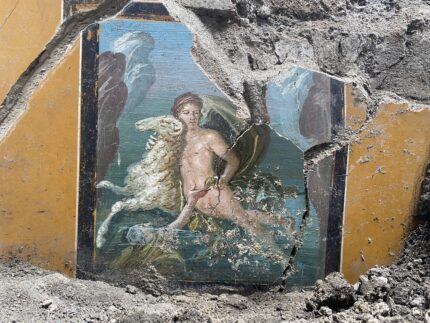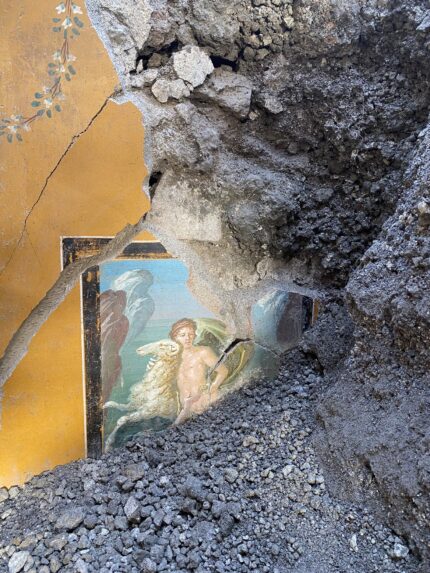 A new fresco has emerged from the House of Leda in Pompeii. Like the fresco that gives the domus its name and the one of Narcissus found in the atrium, this panel also depicts a scene from Greek mythology, the twins Phrixus and Helle fleeing their persecutors on the back of the famed ram with the golden fleece.
A new fresco has emerged from the House of Leda in Pompeii. Like the fresco that gives the domus its name and the one of Narcissus found in the atrium, this panel also depicts a scene from Greek mythology, the twins Phrixus and Helle fleeing their persecutors on the back of the famed ram with the golden fleece.
Phrixus and Helle were the son and daughter of the king of Boeotia and the cloud goddess Nephele. Their evil stepmother Ino bribed an oracle to demand the sacrifice of the twins. Nephele intervened, sending the ram to rescue them in the nick of time. Alas, Helle fell off the ram and drowned. The straight where she plunged to her death was named the Hellespont after her. (It’s the Dardanelles now.) Phrixus would reach Colchis on the Black Sea, marry the daughter of the king and sacrifice the ram to Poseidon. The Golden Fleece became the prize of Colchis and would go on to have a whole other series of adventures courtesy of Jason and the Argonauts.
The fresco captures the moment Helle sinks beneath the waves as she reaches out for Phrixus on the back of the ram. Its palette of blues and teals is still vivid and it is framed in black on the center of a wall painted in solid yellow. It adorns the back wall of the atrium of one of the southern domus, one of two newly-discovered homes that were built in different phases of construction at the House of Leda.
The House is currently being excavated and restored with the ultimate goal of stabilizing the richly frescoed spaces and erecting protective roofs to preserve them from exposure to the elements. The excavation of the site has been ongoing since 2018, and most of the spaces are still partially buried, including the room at the entrance to the house with the Leda and the Swan fresco.
 Tunneling expeditions in the 18th and early 19th centuries already removed some of the layers from the eruption of 79 A.D. from the House of Leda, but they never reached the two connected domuses north and south of it. The parts of the house accessed by the tunnelers have pumice levels covering the walls up to between 20 and 30 inches from the floor. The two domuses, on the other hand, have pumice deposits 13 feet deep, reaching the tops of the surviving walls.
Tunneling expeditions in the 18th and early 19th centuries already removed some of the layers from the eruption of 79 A.D. from the House of Leda, but they never reached the two connected domuses north and south of it. The parts of the house accessed by the tunnelers have pumice levels covering the walls up to between 20 and 30 inches from the floor. The two domuses, on the other hand, have pumice deposits 13 feet deep, reaching the tops of the surviving walls.
The current excavation aim to clarify the full floorplan of the House of Leda, including the perimeters of the main rooms of the northern and southern domus. Archaeologists will also clean the frescoed walls as they go, liberating the vibrant pigment from volcanic residues and deposits and consolidating the surfaces to prevent deterioration now that they’ve been exposed.